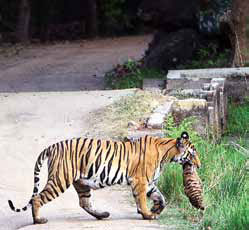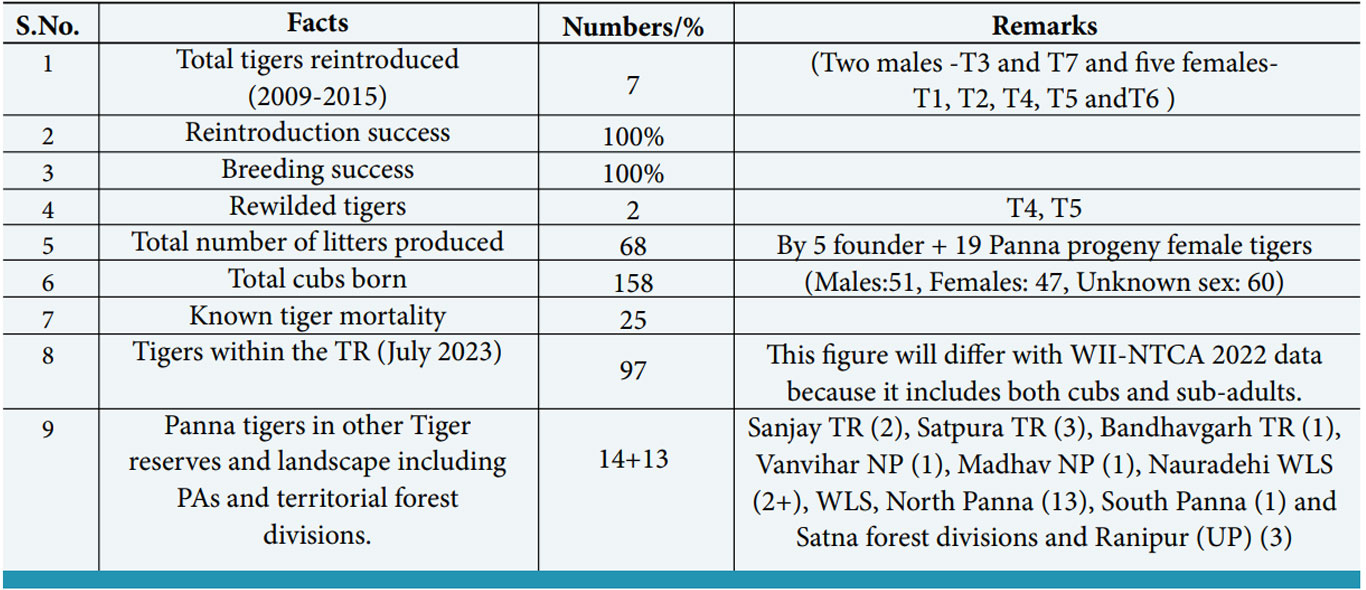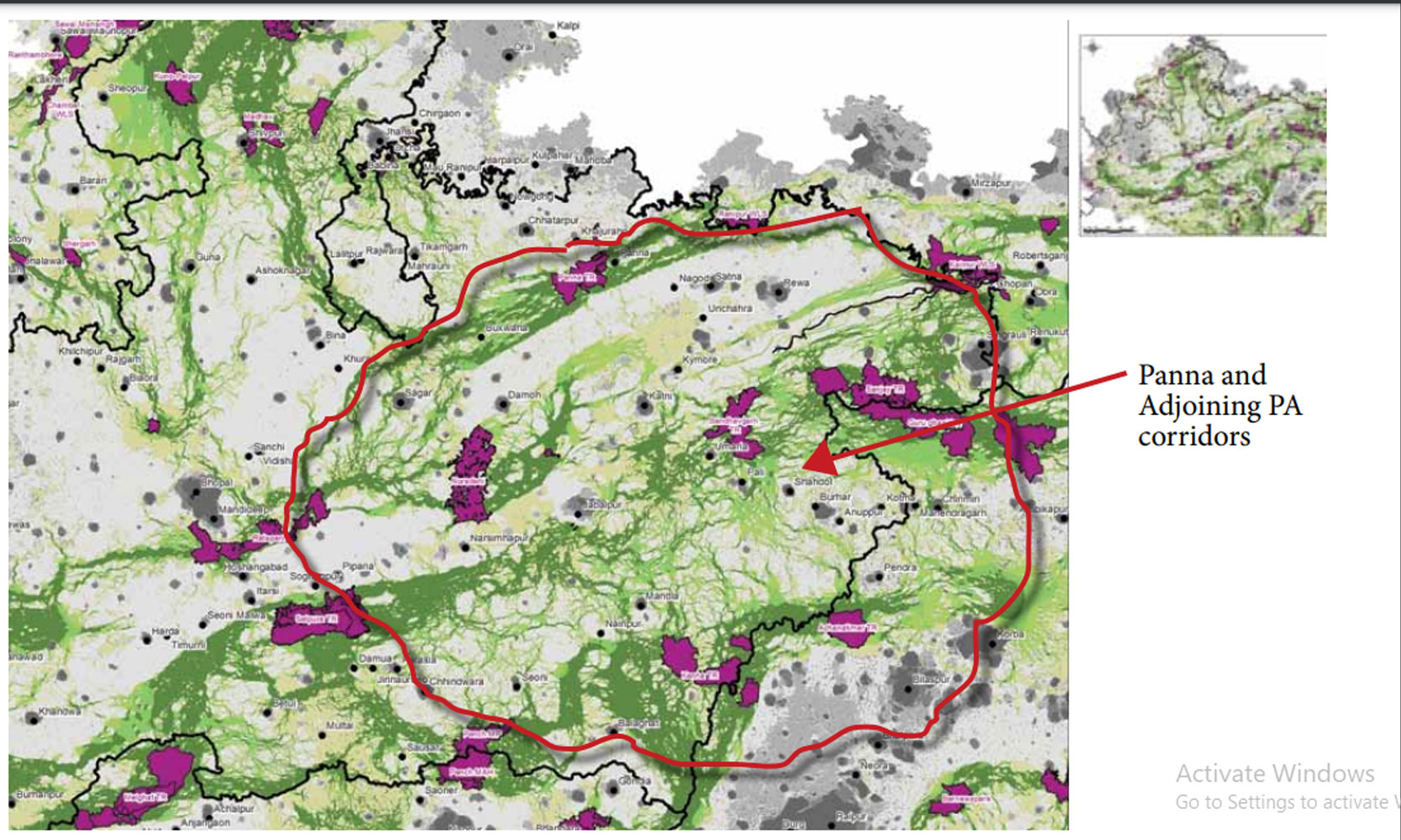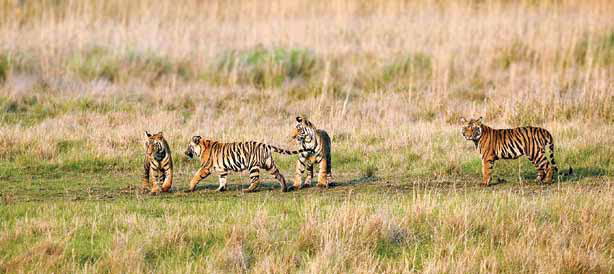
Panna’s Contribution to Tiger Revival Scenario at State, National and International Level
By R. Sreenivasa Murthy IFS Retd.
 On 29th July 2023, Global Tiger Day the latest WII-NTCA Tiger Status Report was released. Madhya Pradesh topped with 785 tigers. The next best was Karnataka with 563 tigers. Shri Shivraj Singh, Hon’ble CM, Madhya Pradesh while expressing his happiness from the stage prominently on global tiger day celebrations from Kushabhau Thakre Convention Centre (Minto Hall) Bhopal specifically recalled Panna tiger revival which led the way to such a stupendous outcome with tiger numbers of the state and regaining of tiger state title. In another function that took place in next 10 days in a different public function of forest department Hon’ble CM again recalled Panna tiger reintroduction for the second time. Recently few months back central forest and climate change minister lauded Panna tiger conservation story at a public function held at Panna specifically taking my name. I was honoured with a civic felicitation in Panna in 2011. Again I was honoured as recently as on 27th Aug 2023 by the Panna local press organisation for my contribution in Panna Tiger Revival as “Tiger Man”. I have my fan following not only at Panna but even outside also. Panna Heritage FB site adopted T1 and Vastala (supposedly oldest living Asian elephant)What makes Panna Tiger Revival so special and etched deeply in the political and public memory even after 13 years is the question I am trying to address here. Simple answer as I see is world’s most successful tiger revival at Panna from ZERO to 55-64 tigers paved the way for the tiger revival story of the state from 257 to 785 between 2009 and 2022 respectively and opened some new windows and avenues of tiger conservation scope at state, national and international level.
On 29th July 2023, Global Tiger Day the latest WII-NTCA Tiger Status Report was released. Madhya Pradesh topped with 785 tigers. The next best was Karnataka with 563 tigers. Shri Shivraj Singh, Hon’ble CM, Madhya Pradesh while expressing his happiness from the stage prominently on global tiger day celebrations from Kushabhau Thakre Convention Centre (Minto Hall) Bhopal specifically recalled Panna tiger revival which led the way to such a stupendous outcome with tiger numbers of the state and regaining of tiger state title. In another function that took place in next 10 days in a different public function of forest department Hon’ble CM again recalled Panna tiger reintroduction for the second time. Recently few months back central forest and climate change minister lauded Panna tiger conservation story at a public function held at Panna specifically taking my name. I was honoured with a civic felicitation in Panna in 2011. Again I was honoured as recently as on 27th Aug 2023 by the Panna local press organisation for my contribution in Panna Tiger Revival as “Tiger Man”. I have my fan following not only at Panna but even outside also. Panna Heritage FB site adopted T1 and Vastala (supposedly oldest living Asian elephant)What makes Panna Tiger Revival so special and etched deeply in the political and public memory even after 13 years is the question I am trying to address here. Simple answer as I see is world’s most successful tiger revival at Panna from ZERO to 55-64 tigers paved the way for the tiger revival story of the state from 257 to 785 between 2009 and 2022 respectively and opened some new windows and avenues of tiger conservation scope at state, national and international level.
Panna tiger debacle appeared in the public domain in 2009. From notified figures of 34+1 in 2005 and 24 in 2006 Panna took a hard landing with ZERO tigers in 2009. This shocked the department, state and the nation for Panna following Sariska for wrong reasons. My posting at Panna as field director took place in May 2009 specifically to revive the tigers at Panna and when I left Panna I handed over 32 tigers (including cubs and sub-adults) in July 2015 to my successor. As per the NTCA report (2022) Panna TR do have 55-63 tigers with another 14 tigers in the immediate landscape. The following table gives a trend of tiger numbers in Panna TR and the state between 2000 and 2022.
Pre Panna debacle scenario (2000-2008)
Till 2005 Madhya Pradesh state used to have annual wild animal census programme. Madhya Pradesh used whole beat count method for major wild animals (herbivores etc.) and specially pug mark method for tigers and panthers. Sariska tiger debacle happened in 2004 followed by Panna in 2009. As a corrective measure NTCA, GOI initiated national level tiger estimations every four year, with a more scientific capture-recapture method from 2006. With this NTCA’s intervention of tiger co-predator and herbivore estimations Madhya Pradesh discontinued the annual wild animal population estimation exercise and between 2005 and 2009 we lost all Panna tigers. If you see tiger figures of the state before 2005, they were pitching around 700+ with almost half of the tigers reported in outside the PAs.
Loss of tigers in Sariska in 2004 became a national issue and brought in a sense of fear among the foresters especially in territorial units about showing tigers in their jurisdictions. The situation resulted in with almost nil tiger numbers outside the tiger reserves in the state. In 2006 the tiger numbers of the state came down by 43% (300) and in 2010 it dwindled further to 257 (37%) when Madhya Pradesh lost its Tiger State title to Karnataka. Losing of all female tigers at Panna was discovered by the state forest department in 2008 and immediately a project to bring in two female tigers was initiated.
Tiger Scenario at Panna TR and State: Table 1
Tiger Status (numbers)

Post Panna debacle tiger reintroduction and rewilding scenario 2009-2023
 Local extinction of tigers in Panna TR came to department’s knowledge in Feb 2009 and default tiger reintroduction at Panna TR started in March 2009 with translocation of T1 and T2. But the actual Panna tiger reintroduction project precisely started in September 2009 with a proper Tiger Revival Project in place. and this project included earlier translocated two female tigers (T1 and T2) into the proposed six founder tigers (Two male and four female) with some supplementations as and when required. T3 was introduced in Nov 2009 and breeding success of T1 and T2 occurred in April and October 2010.
Local extinction of tigers in Panna TR came to department’s knowledge in Feb 2009 and default tiger reintroduction at Panna TR started in March 2009 with translocation of T1 and T2. But the actual Panna tiger reintroduction project precisely started in September 2009 with a proper Tiger Revival Project in place. and this project included earlier translocated two female tigers (T1 and T2) into the proposed six founder tigers (Two male and four female) with some supplementations as and when required. T3 was introduced in Nov 2009 and breeding success of T1 and T2 occurred in April and October 2010.
Tiger rewilding took place in with reintroduction of T4 and T5 in 2011. both these tigers were successfully rewilded and met with breeding success in Nov 2011 and April 2012. T6 was reintroduced in Jan 2014 to address the issue of skewed sex ratio towards male tigers. Second male tiger T7 was successfully reintroduced in Oct 2015. Panna tiger report card (2009-2023) presents a brief success story of Panna tiger revival story.
Tiger Status (numbers)

*Sourced from MP State estimations rest from NTCA
Table 2
Tiger Status (numbers)

Source: Self maintained record, newspaper reports and Field Director, Panna TR bulletins
How tables turned, lessons learnt and overall contribution to tiger conservation
How the tables were turned at Panna, what were the lessons learnt from Panna tiger revival programme and how it contributed to overall tiger conservation scene in the state/nationare some of the curious issues that may hit many. How tables turned at Panna is a long story of which I am not attempting in detail here, but would like to throw some light on major milestone achievements of reintroduction saga. At the same time, I would like to focus my views about some of the important lessons learnt from Panna tiger revival and how it contributed and inspired or influenced to overall tiger conservation scene in the state, nation and even at international level prominently.
How Panna tiger revival turned tables around
Male tiger (T3) was brought from Pench TR in Nov 2009 which moved out of the Panna TR for a month in Dec 2009 who was brought back to panna for second time on 26th Nov 2009. T3 moved in Panna, Chattarpur, Sagar and Damoh districts covering some 10,000 sq km of geographical area (30% of total). I stayed with my technical team on ground with my team including Mr. Vikram Singh Parihar, Dy. Director, Dr. Sanjeev Gupta Veterinarian, Mr. B. R. Gawahde, Asst. Director in open forests for the entire period of 30 days when T3 was captured and brought back to Panna.
While we were out of Panna Mr. M. P. Tamrakar another Asst Director and Mr. I. K. Afridi Range Officer took care of the tiger reserve. When T3 moved out of the Panna TR jurisdiction he taught the team following skills and reversing the negative mindset of the MPFD territorial ground teams about the tigers at that time.
Skills acquired from T3 walk in the landscape
- Gelling of team Panna.
- Skills of managerial radio telemetry based 24×7 monitoring by team Panna.
- Start of losing tiger phobia in the territorial units in the landscape.
- Start of Jan Samarthan se Bagh Samrakshan (tiger conservation with people’s support) spirit.
Of these four important achievements I would like to elaborate the third and fourth points that helped the bringing back of tiger in the landscape outside the TR.
Losing of tiger phobia in territorial units
When the tiger moved out of my jurisdiction (Panna TR), I immediately made phone call around midnight to Mr. Chaddar DFO Damoh on 31st Nov 2009 with some amount of assertion. I had briefed him clearly that now the tiger T3 moving is in his jurisdiction. Our duty as team Panna is limited to technically following him with signal, but the protection of the tiger squarely lies with him since T3 will be his property till he moved in his area. Since Panna Tiger Reintroduction programme was declared a prestigious one for the resurrection of lost glory of tigers at Panna all the concerned DFOs in the landscape immediately started co-operating wilfully. Thus, under compulsory conditions initially the tiger phobia started disappearing but as the time moved on with several accomplishments of Panna revival, the pride that comes with the success had blown away the left-out fear. Late Mr. H. K. Dave who was additional DFO Damoh at that time needs special mention. Of course, the sincerity and supportive nature of CCFs helped to achieve this otherwise impossible task.

Initiation of Jan Samarthan se Bagh Samrakshan (tiger conservation with people’s support) spirit
While analysing the loss of tigers at Panna I realised that to win the trust and cooperation of local people of Panna and Panna landscape is very important. We organised an informal consultation programme of all important and influential locals and other stake holders (political class, tourist operators, locals and all district level bureaucracy -collectors, SPs and DFOs) of the landscape at Madla on 5th Nov 2009 before the start of actual reintroduction progamme. Everyone who were present in the conclave assured their support for the success of Panna Tiger Revival programme. I equated the tiger revival programme as restoration of lost tiger glory of Bundelkhand. Coincidentally next day (6th Nov 2009) T3 landed at Panna to kick start the tiger reintroduction programme and moved out of the park on 25th Nov 2009 night. Thus, while T3 was moving in the landscape I got full support of all the locals of landscape in ensuring his security and bringing him back to Panna. Once breeding success achieved by April 2010 in less than 5 months of T3’s return we started getting overwhelming support of every one from both the public as well as government agencies. And this local support continued with continuous communication with people through several means to earn the trust of one and all.
Interventions from HQ which changed the tiger scenario at state level from 2011 onwards
- Dr Suhas Kumar as APCCF Protection initiated a process of addressing the migrating tigers in the Panna corridors in 2011.
- Strengthening of rescue teams with all TRs.
- Increased protection and managerial capabilities of territorial field units with needed support and timely reviews.
- State funding of voluntary village relocation programme that helped to relocate 202 villages outside the TRs besides relocation of 49 villages from Satpura TR.
- Grassland development in relocated sites in PAs
- Mass capture and translocation of herbivores (cheetal) from surplus areas like Pench and Kanha TR,
Vanvihar NP to low prey PAs like Sanjay TR, Nauradehi WLS etc. - Revamping of Tiger Strike Force and making it effective to control wildlife crime.
- Creation of separate budget head to address the wildlife management outside the protected areas and effective use of available budgetary resources at hand.
All the above well-coordinated managerial interventions and sustained efforts both at state level and field level, present tiger numbers in the State reached 785 that includes 222 tigers in the landscape outside the TRs which is all time high. This speaks volumes about how Panna tiger revival spiralled the tiger conservation outcomes in the immediate landscapes as detailed in the subsequent para adding to the whole.
How Panna landscape tiger occupancy steadily increased with re-establishment of stepping stones, meta populations & tiger population reinforcement in other TRs consequential to above field and HQ level coordinated efforts:
Team Panna constantly monitored her migrating tigers from 2011 till date with her monitoring teams and helped them to settle in new areas
- T38 of Ranthambore TR travelled all along and settled in the forests of Datia for almost eight years starting from 2012. Team Panna supported the Datia team in imparting the skills required to monitor and manage this
lonely tiger. DFO Datia Mr Ninama was also awarded by Panna TR for his zeal to support a tiger in a territorial
division. - In 2015 P213-22 and P121 moved on their own to Sarbhanga forests of Satna district where they started building a meta population. The tigers here constantly move into adjoining Ranipur Sanctuary of UP.
- P213-21 migrated on his own to Bandhavgarh TR in 2017 and settled as T71 there.
- Panna-211 started migrating in Panna-Bijawar-Malthone-Lalithpur(UP) tract who was picked up and introduced at Satpura TR in the year 2012. In later years P-213-22 and 23 were translocated from Panna and
reintroduced at Satpura TR. - P212 started moving in Panna-Mohendra-Maihar-Kaimur tract in 2014 who was picked and introduced at
Sanjay TR This transfer of P212 at Sanjay TR had ignited new energy with the team Sanjay to transform
stepping stone status of Sanjay TR to a tiger source population in the shortest time. And presently Sanjay
TR do have 16 adult tigers. - Panna had contributed founder tigers to Nauradehi (N3) in 2022 and Madhav national park (P141-12) in 2023 to support the tiger reintroductions respectively.
Thus, Panna TR definitely helped to bring back the tigers in the Panna landscape in a bigger way besides reinforcing tigers at Satpura, Sanjay TRs and sharing founder tigers to Nauradehi WLS and Madhav NP.
Lessons learnt through successful Panna Tiger Revival Programme
- Don’t lose hope even when the situations are tough and totally against you.
- Engage local communities in the conservation programme starting from planning phase. People can be associated with tiger conservation positively with proper communication both at tiger reserve and landscape level.
- Managerial radio telemetry-based tiger monitoring discovered at Panna contrasting the academic one which is essential to avoid mortality in founder tigers and minimise the mortality in cubs and sub-adults.
- Capacity building in inhouse tiger handling skills like chemical immobilisation, radio collaring and medicalattendance.
- Tiger reintroductions and tiger revival programme can be taken up successfully with a passionate team at your disposal and a clear reporting line with superiors both at state and GoI level. Senior officer posted at HQ appointed as Mission leader just to give fillip to the Panna tiger reintroduction programme. Following this team Panna voyaged through the journey of tiger revival in a mission mode.
- World’s first ever successful tiger rewilding innovated at Panna (T4 and T5).
- No founder tiger mortality occurred due to short comings in management.
- First breeding success achieved in the shortest ever time after reintroductions (13 months starting with T1 and T2 reintroductions). 100% breeding success in four years of all reintroduced female tigers (T1, T2, T4, T5 and T6).
- Territorial forest division units can be motivated to take-up tiger conservation in their respective areas by overcoming tiger phobia post Panna debacle.
- Landscape level tiger dispersal is achievable even in tough Bundelkhand and Baghelkhand landscapes.
- Metapopulations in the landscapes are achievable.
- Dispersing tigers can be translocated to other potential areas if they are trapped in ecological sinks.
Panna’s contribution to tiger revival scenario at state, national and international level
- Jan Samarthan se Bagh Samrakshan-Tiger Conservation with people’s support: Participation of local people at large is achievable in tiger conservation even in odd situations both in and around a PA and in the landscape. Panna tiger revival model followed the spirit of Jan Samarthan se Bagh Samrakshan-Tiger Conservation with people’s support.
- Invention of managerial radiotelemetry monitoring for successful tiger reintroduction/rewilding: In pre Panna 2009 scenario, radiotelemetry monitoring was primarily used as a part of academic research related to wildlife. But with Panna reintroduction team Panna recognised the importance of 24x7x365 managerial radiotelemetry monitoring to secure and achieve harmony among the introduced tigers and help reintroductions progress in
positive way by ensuring no mortality in founder tigers and minimum mortalities in tiger progenies in the initial phases. - First ever successful tiger reintroduction and rewilding: Mega carnivore like tiger can be reintroduced and rewilded successfully and 100% breeding success achievable in a minimum time period (five years) again against all odds.
- Panna successfully reintroduced all 7 founder tigers without no mortality of founder tigers due to either managerial or security lapse.
- Invented rewilding process of two orphaned tigers namely T4 and T5 (first time in the world).
- Achieved 100% breeding success in all five reintroduced female tigers (T1, T2, T4, T5 and T6) and
- Another rare distinction that Panna achieved and no one including me never imagined is the rare distinction of building the viable tiger population of twenty-two breeding female tigers in 13 years (2023) starting from Zero tigers in 2009 at Panna core.
- Dispelling the Tiger Phobia in the landscape: Panna dispersing tigers and their conservation in the landscape with proper coordination, training of monitoring methods with adjoining territorial divisions removed post Panna tiger debacle phobia (aversion to report tigers) in those territorial forest units that fall in the landscape. DFO Datia Mr. Ninama and DFO North Sagar Mr. Anil Singh were incentivised for their contribution of saving tigers in the landscape in 2012 and 2014 which helped territorial units getting out of tiger phobia created post Panna debacle. Presently 222 tigers are living in Madhya Pradesh in the landscape outside the TRs that include 25+ tigers in the Panna landscape.
- Contribution of Panna’s Tigers for reinforcing tiger populations in Satpura and Sanjay TRs: Translocation of radio collared migrating tigers from Panna tiger corridor sinks to Satpura TR (P211 in 2012, P213-22 and 23 in …) and Sanjay TR (P212 in 2014) helped better tiger monitoring in the respective TRs and presently they hold 50+ and 16+ tigers adding to the state tiger numbers.
- Regaining Tiger State title: With 25-31 tigers Panna TR helped Madhya Pradesh to regain the Tiger State title in 2018.
- Opening doors to repopulate no tiger PAs in the state: Success of Panna Tiger Reintroduction and Tiger Re-wilding helped the state to reintroduce tigers in Nauradehi WLS and Madhav national park and rewilding of 11 orphaned tigers in different sites. Besides, Panna contributed founder tigers to Nauradehi WLS and Madhav NP in the year 2023. Similarly national level tiger reintroductions attempted at Mukundra and Satkotia TRs in Rajasthan and Odisha respectively with varying success percentage as of now.
- Doubling the tiger numbers as per St. Pittsburg declaration: Above said conservation measures contributed to doubling the tiger numbers at state and national level.
- Tiger reintroduction and rewilding SOPs: Above flagged successes contributed significantly to Tiger Reintroduction and rewilding SoP of NTCA.
- International recognition: Cambodia wishes to follow the Panna model of tiger reintroduction. Cambodia team visited Panna TR twice and me was part of the expert team visited to advise them in tiger reintroduction
atters. As a follow up India and Cambodia signed a MOU regarding the reintroduction of tigers in Cambodia on Nov 12, 2022. - Brightened chances of other megacarnivore introductions: Madhya Pradesh and Indian governments show case their success at Panna and other tiger reintroduction and rewilding experiences as their capacity to support of the experimental Intercontinental Cheetah Reintroduction at Kuno which is an ongoing prestigious project.

Thus, Panna tiger reintroduction and tiger rewilding project had emerged as a shining example of achieving success in mega carnivore reintroductions against all odds and becoming a role model of tiger conservation at regional, national and international levels.
Abbreviations: TR- Tiger Reserve, WLS- Wildlife Sanctuary, NP- National Park, NTCA- National Tiger Conservation Authority, SOP- Standard Operating Procedure, DFO- Divisional Forest Officer, SP- Superintendent of Police, T1, T2 etc., – Founder Tiger1, 2 etc., P211- Panna (progeny) Tiger ID.


